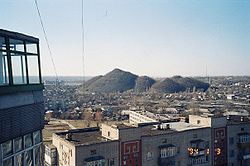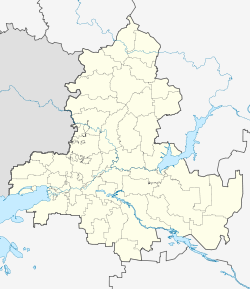Shakhty
Shakhty
Шахты | |
|---|---|
 A view of the city from the KhBK (cotton plant) area | |
| Coordinates: 47°42′N 40°14′E / 47.700°N 40.233°E | |
| Country | Russia |
| Federal subject | Rostov Oblast[1] |
| Founded | beginning of the 19th century[2] |
| Government | |
| • Mayor | Denis Stanislavov[3] |
| Elevation | 100 m (300 ft) |
| Population | |
| • Total | 263,377 |
| • Estimate (2018)[5] | 233,814 (−11.2%) |
| • Rank | 79th in 2010 |
| • Subordinated to | Shakhty Urban Okrug[1] |
| • Capital of | Shakhty Urban Okrug[1] |
| • Urban okrug | Shakhty Urban Okrug[6] |
| • Capital of | Shakhty Urban Okrug[6] |
| Time zone | UTC+3 (MSK |
| Postal code(s)[8] | 346500 |
| Dialing code(s) | +7 8636 |
| OKTMO ID | 60740000001 |
| City Day | Third Sunday of September |
| Website | www |
Shakhty (Russian: Шахты, IPA: [ˈʂaxtɨ]) is a city in Rostov Oblast, Russia, located on the southeastern spur of the Donetsk mountain ridge, 75 kilometers (47 mi) northeast of Rostov-on-Don. As of the 2010 Census, its population was 263,377.[4]
It was previously known as Alexandro-Grushevskaya (until 1867),[2] Gornoye Grushevskoye Poseleniye (until 1881),[2] Alexandrovsk-Grushevsky (until 1920).[2]
History[edit]
In the beginning of the 19th century[2] sergeant-major Popov founded[citation needed] on the Grushevka River a Cossack stanitsa of Alexandro-Grushevskaya (Александро-Грушевская).[2] While the exact reasoning behind this name is unclear, it is possible that the name was given in honor of Emperor Alexander I.[2] Twelve Cossacks and fourteen peasant serfs lived in the stanitsa at that time.[citation needed] By the mid-19th century, fifty-seven coal mines operated in this area.[2] In 1867, it was granted town status and renamed Gornoye Grushevskoye Poseleniye (Горное Грушевское Поселение).[2] The name was changed to Alexandrovsk-Grushevsky (Александровск-Грушевский) in 1881.[2]
By 1914, the population had reached 54,000. The main source of income was coal mining, which had been carried out in that region since the end of the 18th century. The population was poor, but the town had rail, telegraph and telephone networks, electricity and plumbing as well as libraries, hospitals and a post office. 1917 saw the city change hands three times, until it was taken on April 28, 1919, by the Don Army, under General Aleksandr Fitskhelaurov. For twenty months it was independent of the Bolsheviks, but was ravaged by typhoid.
In 1920, the city was given its present name.[2] The name, which literally means mines in Russian, was chosen due to the strong association with coal mining.[2] In 1920–24 Shakhty was part of Donetsk Governorate of the Ukrainian SSR. During the 1920s, many of the churches and the archives were destroyed. In 1928, the city was the location of the Shakhty Trial, a precursor of the show trials of the 1930s.
In 1941, an independent Cossack republic had been declared in Shakhty although this was suppressed by the NKVD before the Russian invasion.[9] In July 22, 1942, during the Great Patriotic War, the city was occupied by the Germans; many coal pits and buildings were blown up by the Germans during their retreat in February 12, 1943. Twenty-nine of the townsmen were awarded the title of the Hero of the Soviet Union.
In 1948, production levels in the mines reached what they had been before the war. During the Leonid Brezhnev years, the city was at the height of its development, with a population of over 250,000, and about ten million tons of coal being mined each year.
In the 1970s and 1980s, the city was the scene of many of Andrei Chikatilo's murders.
Perestroika proved devastating for the city, as mines were privatized and shut down, causing massive unemployment, which led to a severe rise in crime and drug abuse. Today's Shakhty is the main industrial center of the Eastern Donbas. The city is also one of the main producers and exporters of tile in Eastern Europe.
Administrative and municipal status[edit]
Within the framework of administrative divisions, it is incorporated as Shakhty Urban Okrug—an administrative unit with the status equal to that of the districts.[1] As a municipal division, this administrative unit also has urban okrug status.[6]
Demographics[edit]
The city's population was 239,987 as of the 2010 Census;[4] up from 222,592 recorded in the 2002 Census.[10] As of the 1989 Census, the population was 225,797.[11]
Attractions[edit]
There are several monuments and historical sites in Shakhty.


- The Monument to Alexander II was opened on April 29, 2015, located in front of the main building of the Institute of Service and Entrepreneurship of Don State Technological Institute (DSTU) in the city centre of Shakhty. The monument was funded and built on donations. A representative of the house of Romanov, Pavel Eduardovich Kulikovsky-Romanov (great-grandson of Emperor Alexander III), was given the honor of unveiling the monument.
The monument was built by Yuri Alekseevich Levochkin.[12] Its pedestal is made of dark granite, and the statue itself is cast from bronze. The lower half stand 5.7 meters high, and the figure of Alexander II is another 2.4 meters. On the front side, there is an engraving in gold letters that reads, "Alexander II. Tsar the Liberator". Viewed from the back, there is a brief biographical note on the ruler—"Emperor Alexander II abolished serfdom in Russia in 1861 and freed millions of peasants from centuries of slavery, conducted military and judicial reforms, introduced the system of local self-government, city dumas and local administrations, brought to an end the long-lasting Caucasian War, and liberated the Slavic peoples from the Ottoman yoke. He was killed on March 1, 1881 and was a victim of a terrorist."[13][14]

The monument was erected on an initiative of the Historical Council of the City of Shakhty.
- Monument to Vasily Alexeyev (2014), a Soviet weightlifter.[15][16] He set 80 world records and 81 Soviet records in weightlifting, and won gold medals at the 1972 and 1976 Summer Olympics.[17] Alexeyev was born in Shakhty.
- Monument to Soldier-liberator (1985)
- Memorial to the Victims of Fascism (1975)
- Monument to the fighters for Soviet power (1955)
- Monument to soldiers-internazionalista (2010)
- Monument to Taras Shevchenko (1972)
- Monuments to Lenin (1945). Vladimir Ilyich Ulyanov was a Russian communist revolutionary, politician and political theorist.
- A memorial to the heroes of the first world war (2014). On the monument depicts a double-headed eagle. In his paws cadet standard, with the monogram of the Russian Emperor Nicholas II. On the plates under the wings of the eagle is engraved the names of all of the Don Cossack units that participated in the First World War.
- Saint Alexander Nevsky Church
Twin towns – sister cities[edit]
 Armavir, Armenia
Armavir, Armenia Gelsenkirchen, Germany
Gelsenkirchen, Germany Nikopol, Bulgaria
Nikopol, Bulgaria Sievierodonetsk, Ukraine
Sievierodonetsk, Ukraine
Notable people[edit]
- Vasily Alexeyev (born 1942), weightlifter
- Lyudmila Kondratyeva (born 1958), sprinter
- Alina Ermolova (born 2001), rhythmic gymnast
- Marina Logvinenko (born 1961), sport shooter
- Alexander Nevolin-Svetov (born 1988), Paralympic swimmer
- Kor-Lay (born 1998), Russian singer
References[edit]
Notes[edit]
- ^ a b c d e Law #340-ZS
- ^ a b c d e f g h i j k l Pospelov, p. 26
- ^ Official website of Shakhty Administration. Denis Ivanovich Stanislavov Archived March 11, 2014, at the Wayback Machine (in Russian)
- ^ a b c Russian Federal State Statistics Service (2011). Всероссийская перепись населения 2010 года. Том 1 [2010 All-Russian Population Census, vol. 1]. Всероссийская перепись населения 2010 года [2010 All-Russia Population Census] (in Russian). Federal State Statistics Service.
- ^ "26. Численность постоянного населения Российской Федерации по муниципальным образованиям на 1 января 2018 года". Federal State Statistics Service. Retrieved January 23, 2019.
- ^ a b c Law #191-ZS
- ^ "Об исчислении времени". Официальный интернет-портал правовой информации (in Russian). June 3, 2011. Retrieved January 19, 2019.
- ^ Почта России. Информационно-вычислительный центр ОАСУ РПО. (Russian Post). Поиск объектов почтовой связи (Postal Objects Search) (in Russian)
- ^ p.88, Stalingrad, Antony Beevor
- ^ Russian Federal State Statistics Service (May 21, 2004). Численность населения России, субъектов Российской Федерации в составе федеральных округов, районов, городских поселений, сельских населённых пунктов – районных центров и сельских населённых пунктов с населением 3 тысячи и более человек [Population of Russia, Its Federal Districts, Federal Subjects, Districts, Urban Localities, Rural Localities—Administrative Centers, and Rural Localities with Population of Over 3,000] (XLS). Всероссийская перепись населения 2002 года [All-Russia Population Census of 2002] (in Russian).
- ^ Всесоюзная перепись населения 1989 г. Численность наличного населения союзных и автономных республик, автономных областей и округов, краёв, областей, районов, городских поселений и сёл-райцентров [All Union Population Census of 1989: Present Population of Union and Autonomous Republics, Autonomous Oblasts and Okrugs, Krais, Oblasts, Districts, Urban Settlements, and Villages Serving as District Administrative Centers]. Всесоюзная перепись населения 1989 года [All-Union Population Census of 1989] (in Russian). Институт демографии Национального исследовательского университета: Высшая школа экономики [Institute of Demography at the National Research University: Higher School of Economics]. 1989 – via Demoscope Weekly.
- ^ "В Шахтах начали устанавливать памятник Александру II". kvu.su (in Russian). Retrieved October 7, 2017.
- ^ "Члены ИППО приняли участие в открытии памятника императору Александру II в Шахтах". ippo.ru. Retrieved October 7, 2017.
- ^ "В городе Шахты открылся памятник Александру II - Администрация города Шахты". shakhty-gorod.ru. Retrieved October 7, 2017.
- ^ Fyodorov, Gennady (November 25, 2011). "Weightlifting-World record holder Alekseyev dies at 69". Reuters. Retrieved November 25, 2011.
- ^ Croft, Lee B (2002) [1992]. Dawson, Dawn P (ed.). Great Athletes. Vol. 1 (Revised ed.). Salem Press. pp. 35–37. ISBN 1-58765-008-8.
- ^ Vasily Alekseyev Archived 22 June 2016 at the Wayback Machine. sports-reference.com
- ^ "Города-побратимы". shakhty-gorod.ru (in Russian). Shakhty. Retrieved February 4, 2020.
Sources[edit]
- Законодательное Собрание Ростовской области. Закон №340-ЗС от 25 июля 2005 г. «Об административно-территориальном устройстве Ростовской области», в ред. Закона №270-ЗС от 27 ноября 2014 г. «О внесении изменений в областной Закон "Об административно-территориальном устройстве Ростовской области"». Вступил в силу со дня официального опубликования. Опубликован: "Наше время", №187–190, 28 июля 2005 г. (Legislative Assembly of Rostov Oblast. Law #340-ZS of July 28, 2005 On the Administrative-Territorial Structure of Rostov Oblast, as amended by the Law #270-ZS of November 27, 2014 On Amending the Oblast Law "On the Administrative-Territorial Structure of Rostov Oblast". Effective as of the official publication date.).
- Законодательное Собрание Ростовской области. Закон №191-ЗС от 19 ноября 2004 г. «Об установлении границы и наделении статусом городского округа муниципального образования "Город Шахты"», в ред. Закона №627-ЗС от 12 января 2007 г «О внесении изменений в некоторые областные Законы об установлении границ муниципальных образований и наделении их соответствующим статусом». Вступил в силу со дня официального опубликования. Опубликован: "Наше время", №285–286, 23 ноября 2004 г. (Legislative Assembly of Rostov Oblast. Law #191-ZS of November 19, 2004 On Establishing the Border and Granting Urban Okrug Status to the Municipal Formation of the "City of Shakhty", as amended by the Law #627-ZS of January 12, 2007 On Amending Various Oblast Laws on Establishing the Borders of the Municipal Formations and on Granting Them an Appropriate Status. Effective as of the official publication date.).
- Е. М. Поспелов (Ye. M. Pospelov). "Имена городов: вчера и сегодня (1917–1992). Топонимический словарь." (City Names: Yesterday and Today (1917–1992). Toponymic Dictionary.) Москва, "Русские словари", 1993.
External links[edit]
- Official website of Shakhty (in Russian)
- Unofficial website of Shakhty (in Russian)





